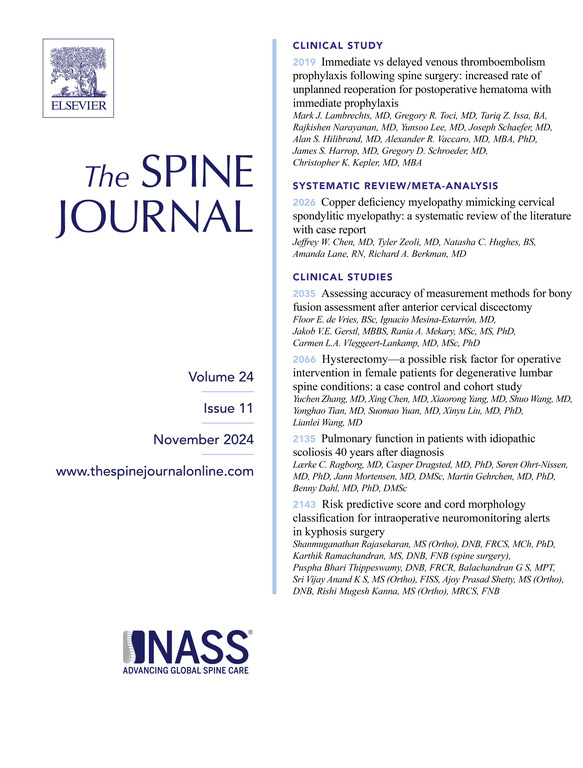用于预测腰椎后路椎体间融合术中腰椎管狭窄症手术时间延长的机器学习模型的开发:一项多中心研究。
IF 4.7
1区 医学
Q1 CLINICAL NEUROLOGY
引用次数: 0
摘要
背景情况:腰椎管狭窄症患者的后路腰椎椎间融合术(PLIF)手术时间过长会导致更多并发症,并对术后恢复产生不利影响。因此,亟需一种方法来准确预测有手术时间延长风险的患者。目的:本研究旨在开发一种临床模型,以预测接受 PLIF 手术的患者手术时间延长的情况:本研究采用机器学习方法分析回顾性收集的数据:2015年1月至2022年12月,中国22家医院的3233名确诊为腰椎管狭窄症(LSS)的患者接受了后路腰椎椎间融合术(PLIF):主要结果为手术时间。延长手术时间是指手术时间超过总手术时间的75%,即超过240分钟:方法:根据不同地区将3233名接受PLIF手术的腰椎管狭窄症(LSS)患者分为1个培训组和4个试验组。培训组包括 1569 名患者,测试 1 有 541 名患者,测试 2 有 403 名患者,测试 3 有 351 名患者,测试 4 有 369 名患者。变量包括人口统计学、围手术期细节、术前实验室检查和其他附加因素。变量筛选采用了六种算法,通过两种以上筛选方法确定的变量被纳入最终模型。在训练队列中,利用 10 倍交叉验证(CV)和贝叶斯超参数优化技术,使用 11 种机器学习算法构建了一个模型。随后,使用四个独立的外部测试集对该模型进行评估,并计算平均曲线下面积(AUC),以确定表现最佳的模型。对最佳模型的其他性能指标进行了评估,并使用 SHapley Additive exPlanations(SHAP)进行可解释性分析,以提高决策透明度。最终,创建了一个在线计算器:与其他机器学习模型相比,在各种机器学习模型中,随机森林模型在验证集上的表现最好,测试 1 的 AUROC 得分为 0.832,测试 2 的 AUROC 得分为 0.834,测试 3 的 AUROC 得分为 0.816,测试 4 的 AUROC 得分为 0.822。影响最大的变量是融合级数、APTT 前值、体重和年龄。通过开发一个用于临床应用的网络计算器,该预测模型得到了进一步完善。(https://wenle.shinyapps.io/PPOT_LSS/)结论:该预测模型有助于识别 PLIF 手术后手术时间延长的风险。预测计算器有望改善术前规划,识别具有高风险因素的患者,并帮助临床医生改进治疗方案和实施临床干预。本文章由计算机程序翻译,如有差异,请以英文原文为准。
Development of machine learning model for predicting prolonged operation time in lumbar stenosis undergoing posterior lumbar interbody fusion: a multicenter study
BACKGROUND CONTEXT
Longer posterior lumbar interbody fusion (PLIF) surgeries for individuals with lumbar spinal stenosis are linked to more complications and negatively affect recovery after the operation. Therefore, there is a critical need for a method to accurately predict patients who are at risk for prolonged operation times.
PURPOSE
This research aimed to develop a clinical model to predict prolonged operation time for patients undergoing PLIF procedures.
STUDY DESIGN/SETTING
This study employs a machine-learning approach to analyze data retrospectively collected.
PATIENT SAMPLE
About 3,233 patients diagnosed with lumbar spinal stenosis (LSS) had posterior lumbar interbody fusion (PLIF) at 22 hospitals in China from January 2015 to December 2022.
OUTCOME MEASURES
The primary outcome was operation time. Prolonged operation time defined as exceeded 75% of the overall surgical duration, which mean exceeding 240 minutes.
METHODS
A total of 3,233 patients who underwent PLIF surgery with lumbar spinal stenosis (LSS) were divided into one training group and four test groups based on different district areas. The training group included 1,569 patients, while Test1 had 541, Test2 had 403, Test3 had 351, and Test4 had 369 patients. Variables consisted of demographics, perioperative details, preoperative laboratory examinations and other Additional factors. Six algorithms were employed for variable screening, and variables identified by more than two screening methods were incorporated into the final model. In the training cohort, a 10-fold cross-validation (CV) and Bayesian hyperparameter optimization techniques were utilized to construct a model using eleven machine learning algorithms. Following this, the model was evaluated using four separate external test sets, and the mean Area Under the Curve (AUC) was computed to determine the best-performing model. Further performance metrics of the best model were evaluated, and SHapley Additive exPlanations (SHAP) were used for interpretability analysis to enhance decision-making transparency. Ultimately, an online calculator was created.
RESULTS
Among the various machine learning models, the Random Forest achieved the highest performance in the validation set, with AUROC scores of 0.832 in Test1, 0.834 in Test2, 0.816 inTest3, 0.822 in Test4) compared with other machine learning models. The top contributing variables were number of levels fusion, pre-APTT, weight and age. The predictive model was further refined by developing a web-based calculator for clinical application (https://wenle.shinyapps.io/PPOT_LSS/).
CONCLUSIONS
This predictive model can facilitate identification of risk for prolonged operation time following PLIF surgery. Predictive calculators are expected to improve preoperative planning, identify patients with high risk factors, and help clinicians facilitating the improvement of treatment plans and the implementation of clinical intervention.
求助全文
通过发布文献求助,成功后即可免费获取论文全文。
去求助
来源期刊

Spine Journal
医学-临床神经学
CiteScore
8.20
自引率
6.70%
发文量
680
审稿时长
13.1 weeks
期刊介绍:
The Spine Journal, the official journal of the North American Spine Society, is an international and multidisciplinary journal that publishes original, peer-reviewed articles on research and treatment related to the spine and spine care, including basic science and clinical investigations. It is a condition of publication that manuscripts submitted to The Spine Journal have not been published, and will not be simultaneously submitted or published elsewhere. The Spine Journal also publishes major reviews of specific topics by acknowledged authorities, technical notes, teaching editorials, and other special features, Letters to the Editor-in-Chief are encouraged.
 求助内容:
求助内容: 应助结果提醒方式:
应助结果提醒方式:


